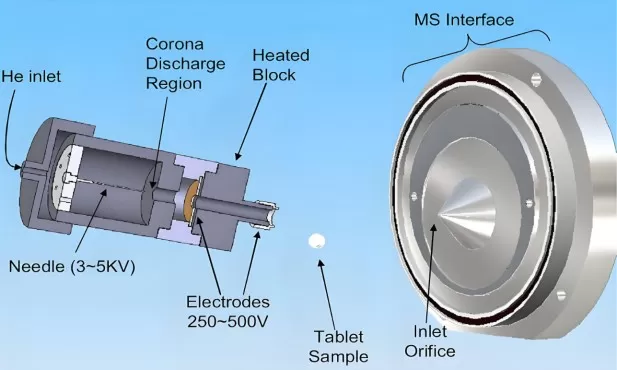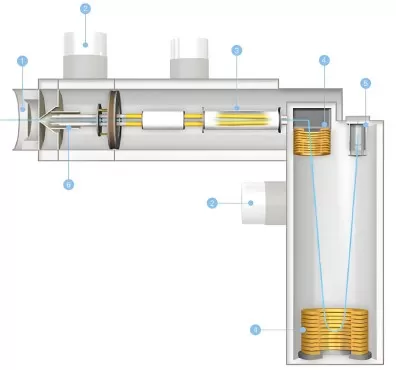Deconstructing Mass Spectrometry: A Comprehensive Guide to Instrumentation and Applications
A mass spectrometer (MS) is a sophisticated analytical instrument capable of generating ions and analyzing the composition and structure of substances based on their mass-to-charge ratio (m/z). Its core principle involves ionizing a sample, separating ions by m/z using electromagnetic fields, and detecting their relative abundance to generate a mass spectrum. Mass spectrometry has become a cornerstone of modern analytical science, with applications spanning chemistry, biology, environmental studies, pharmaceuticals, and clinical diagnostics. This article provides a comprehensive overview of mass spectrometry, including its components, ionization techniques, mass analyzers, detectors, workflows, and key databases used in proteomics and metabolomics.
1. Components of a Mass Spectrometer
A mass spectrometer consists of four primary components:
1. Inlet System: Introduces the sample into the instrument, often interfaced with gas chromatography (GC) or liquid chromatography (LC) for separation.
2. Ion Source: Converts neutral molecules into charged ions. Common ionization methods include electron ionization (EI), electrospray ionization (ESI), and matrix-assisted laser desorption/ionization (MALDI).
3. Mass Analyzer: Separates ions by m/z using technologies such as quadrupoles, time-of-flight (TOF), ion traps, Orbitrap, or Fourier transform ion cyclotron resonance (FT-ICR).
4. Detector: Converts ion signals into measurable electrical data. Examples include electron multipliers, microchannel plates (MCPs), and Daly detectors.
2. Ionization Sources
2.1 Electron Ionization (EI)
EI bombards gaseous molecules with high-energy electrons, causing ionization via electron ejection. Widely used in GC-MS, EI is ideal for small, thermally stable molecules.
2.2 Chemical Ionization (CI)
CI employs reactive reagent ions (e.g., H+) to ionize samples through proton transfer. This softer method suits compounds prone to fragmentation under EI.
2.3 Fast Atom Bombardment (FAB)
FAB uses high-energy inert atoms (e.g., argon) to sputter ions from solid or liquid samples. It is versatile for non-volatile or labile compounds.
2.4 Matrix-Assisted Laser Desorption/Ionization (MALDI)
MALDI employs a laser to desorb and ionize samples embedded in a light-absorbing matrix. It excels in analyzing large biomolecules like proteins and nucleic acids.
2.5 Electrospray Ionization (ESI)
ESI generates charged droplets from a liquid sample under high voltage, producing gas-phase ions after solvent evaporation. ESI is ideal for polar biomolecules and is the backbone of LC-MS.
2.6 Atmospheric Pressure Photoionization (APPI)
APPI uses ultraviolet light to ionize molecules at atmospheric pressure, suitable for non-polar or low-polarity compounds.
2.7 Atmospheric Pressure Chemical Ionization (APCI)
APCI combines nebulization and corona discharge to ionize samples, ideal for medium-polarity molecules in LC-MS workflows.

MS Ion Source
3. Mass Analyzers
3.1 Time-of-Flight (TOF)
TOF measures the time ions take to travel a fixed distance. High mass range and speed make TOF ideal for large molecules and complex mixtures.
3.2 Quadrupole
Quadrupoles filter ions using oscillating electric fields, allowing only specific m/z ions to pass. Cost-effective and robust, they are widely used in routine analysis.
3.3 Linear Ion Trap
Linear traps store ions in a radial electric field, enabling multi-stage MS (MSn) for structural elucidation.
3.4 Orbitrap
Orbitrap traps ions in an electrostatic field, detecting their oscillations via image currents. It offers ultrahigh resolution (>240,000) and accuracy, dominating proteomics and metabolomics.
3.5 Fourier Transform Ion Cyclotron Resonance (FT-ICR)
FT-ICR measures ion cyclotron frequencies in a magnetic field, achieving the highest resolution (>1,000,000). It is used for ultra-complex samples but requires significant infrastructure.

Mass Spectrometer Mass Analyzer
4. Detectors
4.1 Electron Multiplier
The electron multiplier is a highly sensitive detector that amplifies signals by multiplying electrons generated from individual incident ions. When ions strike the detector surface, they release electrons, which are then accelerated and collide with other surfaces, producing additional electrons. Through a cascade of multiplication stages, this process generates a significantly amplified current signal, enabling precise measurement and analysis.
4.2 Microchannel Plate Detector (MCP)
The Microchannel Plate Detector (MCP) is a fast-response detector consisting of an array of microscopic channels, each capable of amplifying signals produced by ion impacts. MCPs are widely used in time-of-flight mass spectrometers, offering rapid and highly sensitive ion detection capabilities.
4.3 Daly Detector
The Daly Detector employs a continuous dynode array, allowing it to count ions and measure a broad range of ion currents. Known for its high sensitivity and excellent linear response, this detector is a preferred choice for many applications requiring precise ion detection.
4.4 Focal Plane Detectors
Focal Plane Detectors are two-dimensional detectors designed to simultaneously detect and spatially locate multiple ions. Commonly used in imaging mass spectrometers, they provide detailed spatial distribution information of ions, facilitating the analysis of ion source uniformity and enhancing the accuracy of mass spectral data.
These detectors play a pivotal role in mass spectrometry by converting ion signals into electrical signals for data acquisition and processing. Selecting the appropriate detector for specific applications can significantly improve the sensitivity and accuracy of the analysis.
Mass spectrometry is a groundbreaking technology renowned for its exceptional sensitivity, resolution, and versatility. Its applications range from deciphering molecular structures in drug development to profiling proteins and metabolites within intricate biological systems. Innovations in miniaturization, automation, and hybrid instrumentation, such as Orbitrap-Q-TOF systems, are continually expanding the frontiers of analytical science. With the evolution of databases and computational tools, mass spectrometry is poised to play an increasingly vital role in precision medicine, environmental monitoring, and a host of other fields.


